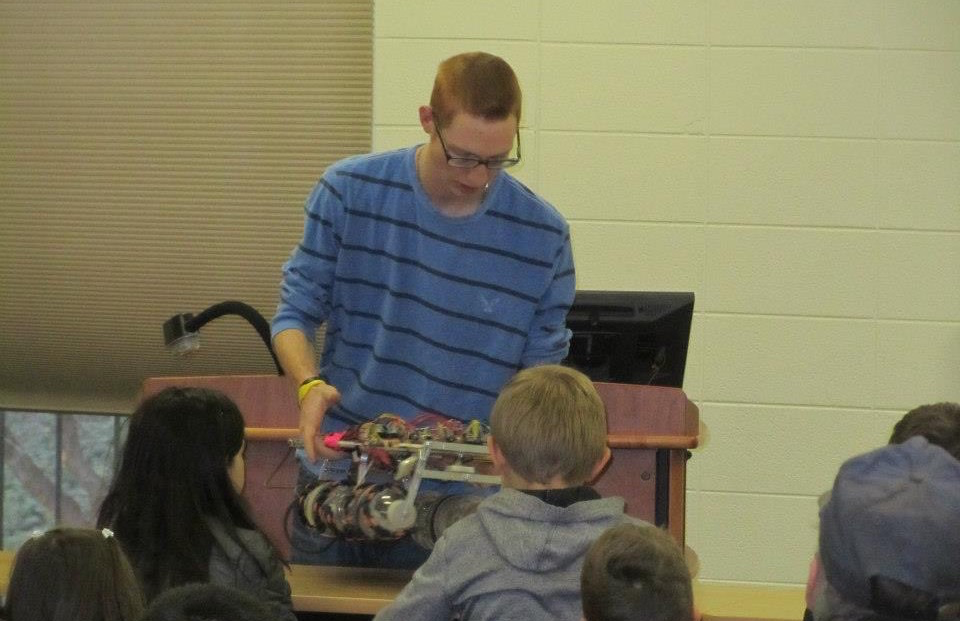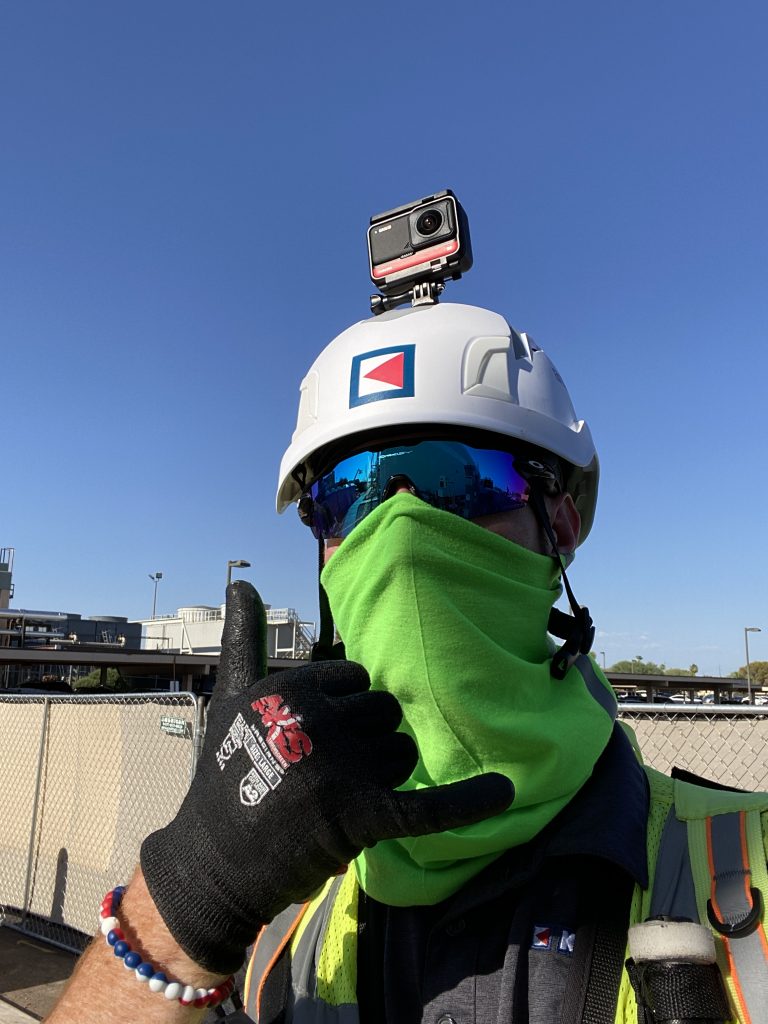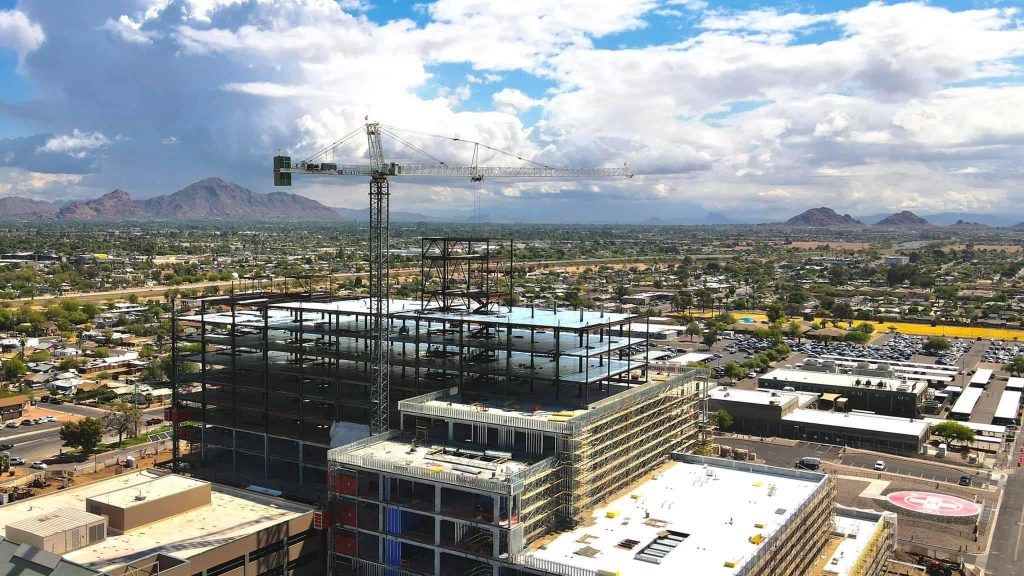Meet Jeff Manders, an Athlete Turned Robot Builder Who Discovered a Love for Construction
July 30, 2021

Meet our July Pathfinder, Jeff Manders, a Field Engineer for Kitchell based out of Phoenix. He joined his college’s robotics team after deciding to stop playing baseball, and his love for building things ultimately led him to a career in construction.
A Passion for Team Sports from an Early Age

Jeff grew up in Louisville, Colorado, just outside of Boulder, with an older brother (five years his senior) and a sister who was two years younger. His father was an agent for 33 years with Farmers Insurance, while his mother worked in various roles in the local public schools. Between the two of them, they seemed to know just about everyone in town.

Jeff grew up wanting to follow in the footsteps of his older brother, which led him to play baseball, football, and other sports.
He actually started playing baseball at age three after his dad fibbed about his age so he could register for tee-ball a year earlier than the usual cut-off.
He was extremely competitive from a young age and can recall hitting a fly ball that hit the outfielder, who was picking dandelions instead of paying attention to the game, on the head.
Jeff just kept running the bases. (The outfielder was fine.)
Transitioning from Baseball to Robotics
After high school, Jeff attended Trinidad State Junior College on a baseball scholarship. The school was three hours south of home, just north of the New Mexico border in Colorado. He played for a semester before making a serendipitous transition to the robotics team. Trinidad State was small, and he was one of only 13 students in his Calculus class. His professor, who knew he had recently stopped playing baseball, ran the robotics program and encouraged him to join.
“It was a substantial change of environment at that point in my life,” he said.

The team was involved in a statewide competition sponsored by NASA and the University of Colorado to build a robot that could navigate through Great Sand Dunes National Park in southern Colorado. Jeff’s role was to build the actual robot, while his teammates focused on the programming and electrical work. He spent hours and hours in the woodshop, cutting out plastic pieces and using CAD software to do the modeling.
It was a natural extension of his interests in high school, where he was strong in math and science and always “hands-on.”
Studying Mechanical Engineering in College
Jeff transferred from Trinidad State to the University of Colorado Boulder after receiving a grant from the Colorado Space Grant Consortium, which ran the robotics competition. As part of the grant, he worked on a satellite project called PolarCube with a focus on using radiometry to create tropospheric temperature profiles to observe weather phenomena and study sea ice fractions in the Polar regions. Specifically, he was in the machine shop making components for satellite prototypes with advanced radiometry capabilities.

He graduated from CU in December 2016 with a mechanical engineering degree and was unsure of what he wanted to do next—apart from the certainty that he didn’t want to spend his working days in a windowless basement lab. One of his seven roommates had been a Project Engineer for a mechanical contractor while they were still in school and seemed to enjoy it most of the time, so Jeff wound up asking him for a rundown.
“It sounded like something I wanted to give a shot,” he said. In retrospect, Jeff thinks his lifelong interest in building things helped lead him into construction. “My interest started with machines and gears, and now it’s whole buildings,” he said.
Getting a Foot in the Door with Kitchell
Jeff moved to Arizona in July 2017 and lived with his older brother, Joe, and his wife while job hunting. He got a lucky break when Joe attended a charity golf tournament and met someone from Kitchell, a general contractor based in Phoenix, who said they were hiring.

Jeff sent his resume and landed an interview a week later. He knew he didn’t have a construction background or a construction management degree like other applicants, but he was confident he could figure out the job after getting through engineering school since engineering is ultimately about problem-solving. He was hired as a Project Engineer and started in October 2017.

In his first weeks and months on the job, absolutely everything was new—from wearing a hard hat to understanding what parts of a building were called to digging for underground utilities. His first project was a three-man job where it was just him, a Project Manager, and a Superintendent on the Kitchell side.
“The amount of information I took in during my first year was immense,” he said.
Working on a 10-Story Hospital Project
After the initial small project, Jeff was transferred to Valleywise Health Medical Center, a 10-story, 700,000-square-foot hospital in Phoenix with a renowned burn center. He was initially a Vicon Engineer on the project, focusing on BIM coordination and VDC work and putting his interest in technology to use.

His first assignment was to collect data on the condition of underground utilities at the 50-year-old hospital, which his team accomplished by potholing at night and using Total Station. The as-built documentation was unfortunately all on paper and difficult to read—and also not entirely reliable—and Kitchell needed to make sure they had an accurate understanding of the location of existing utilities to avoid hitting a power line or water main during construction. (The stakes of getting it right are especially high at an active hospital since patients’ lives could be at risk if the electricity is cut.)
Jeff had to upload the data every night so the BIM team could model it the next day for coordination purposes and to plan where new utilities should go in.
While on the Vicon team, he learned to fly a drone, model in Revit, and utilize Navisworks in the field. He eventually transitioned into various field roles on the Valleywise campus, including taking on responsibility for signage and wayfinding.
“We took out hundreds and hundreds of parking spaces and cut the campus almost in half in terms of access points,” he explained. “It’s critical for the operation of the hospital to make sure that patients, doctors, and vendors can navigate the campus.”
Using OpenSpace to Facilitate Coordination and Scheduling

Jeff was first asked to try OpenSpace about a year ago as part of an effort at Kitchell to evaluate 360 photo documentation platforms. Another platform he tested required users to tap on the floor plan to place imagery, which was time-consuming. He was immediately impressed by how OpenSpace automatically maps imagery to the plan and how it works in the background, allowing him to take phone calls, send emails, or handle other tasks.
“There’s so much automation that would be hours and hours of work otherwise,” he said.
He was also struck by how OpenSpace enables a side-by-side view of actual site conditions with the BIM model, which also impressed Kitchell executives, who wanted to know how all the money spent on BIM coordination was translating in the field.
Jeff is now capturing at least one floor at Valleywise every day since all he needs to do is strap his 360 camera to his hard hat and walk. Up-to-date imagery serves a number of purposes, including coordination and time savings. Instead of having to walk across the enormous building to scope out an issue in a specific room, two people on the project can simply pull up the most recent OpenSpace capture on their phones.
Kitchell has also been utilizing OpenSpace captures to maintain and input actual dates. This helps Superintendents stay on top of progress and identify any scopes that may be slipping.
“It’s very cool to see OpenSpace incorporated in the weekly workflow,” Jeff said. “I didn’t even tell our scheduler to do it; he just pulled in the captures on his own.”
Committing to Construction and Planning for the Future

Jeff loves the construction industry and is in it for the long haul. “I like the team aspect and coming out every day together. It’s like a ‘Band of Brothers’ (and sisters) feeling,” he said. “We’re out here building America together.”
He takes pride in leveraging technology and showing his colleagues—some of whom have been in the industry for decades—how it can improve existing processes. Sometimes it’s as simple as showing them how to use Airdrop to share files or how to scan a QR code, and sometimes it’s integrating a cutting-edge platform like OpenSpace.
“I explain that they have gigabytes of data to look at anything on the job—and all from their phones,” he said. “They’re usually blown away by that.”
What Does it Mean to be a Pathfinder?

For Jeff, being a Pathfinder means thinking outside the box—and being able to handle exploring unknown territory with the knowledge that you might fail the first time. Not every solution has to be technology-based, but he’s bullish about the power of technology to improve a variety of processes and workflows.
Pathfinders are power users like Jeff who excel at using OpenSpace. You can check out all of our published Pathfinder Spotlights in the OpenSpace Community gallery. If you’d like to be a Pathfinder, submit your Pathfinder application today.

